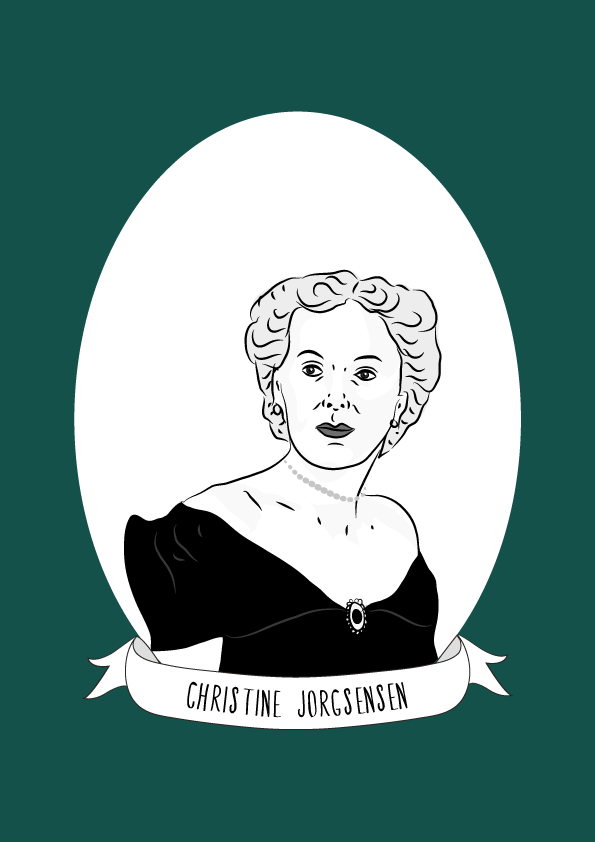Christine Jorgensen was an American trans woman who was the first person to become widely known in the United States for having gender reassignment surgery.
Jorgensen was born in 1927 in the Bronx, New York City. From an early age, she knew that she identified as female and hated having to wear traditionally male clothes, coveting her sister Dorothy’s pretty dresses. As a teenager, her gender dysphoria increased and she became envious of the girls in her school. To escape from her discomfort, Jorgensen found solace in photography and set up a darkroom at home with her father while taking classes at the New York Institute of Photography.
In 1945, Jorgensen was drafted into the military where she worked as a clerk due to her slight stature. A year later, she was discharged from the military and returned to New York. Jorgensen discovered a possible solution to her feeling trapped in the wrong body in gender reassignment surgery. With the help of a doctor, she began taking the female hormone ethinyl estradiol and researching the surgery, which was then illegal in most countries. Jorgensen intended to travel for Sweden for her operation, but during a stopover in Copenhagen she met Dr. Christian Hamburger, a Danish endocrinologist and specialist in rehabilitative hormonal therapy. In 1951, Jorgensen had the first of a series of operations and wrote to a friend “”As you can see by the enclosed photos, taken just before the operation, I have changed a great deal. But it is the other changes that are so much more important. Remember the shy, miserable person who left America? Well, that person is no more and, as you can see, I’m in marvellous spirits.“ A year later, she had a second procedure before returning to the U.S. to headlines including “Bronx ‘Boy’ Is Now a Girl” and “Dear Mum and Dad, Son Wrote, Have Now Become Your Daughter.”
Jorgensen was initially uncomfortable with the attention her gender reassignment surgery had brought her, but soon realised that she was able to control her own press. In 1953, Jorgensen wrote “The Story of My Life” which was published in The American Weekly, and she was the most-written about person that year. Jorgensen used her fame as a platform to advocate for transgender individuals and became a role model for those who were struggling with their gender identities. She received letters from all over the world, and encouraged others who identified as transgender to change their sex on birth certificates and to change their names. For the first time, people had to examine the previously held notion that gender was a set binary and doctors began to use the terms “psychological sex” and “biological sex”. Jorgensen was an example of someone whose biological sex and psychological sex didn’t match up, and she saw herself as a founding member in what became known as the “sexual revolution”.
In 1959, Jorgensen became engaged to Howard J. Knox, a typist. The couple were faced with discrimination, and were unable to obtain a marriage license because Jorgensen’s birth certificate listed her as male. Knox lost his job when his engagement to Jorgensen was announced. Despite this, many celebrated her and in 1967 her biography Christine Jorgensen: A Personal Biography was published followed by a film entitled The Christine Jorgensen Story a year later.
During the 1970’s and early 80’s, Jorgensen continued to spread awareness of issues relating to gender identity and toured university campuses and other venues to speak about her experiences. In addition to her advocacy, Jorgensen worked as an actress and nightclub entertainer, performing several songs including “I Enjoy Being a Girl”. In 1984, she returned to Copenhagen were she performed her show and featured in Teit Ritzau’s Danish transsexual documentary film Paradiset er ikke til salg (Paradise Is Not for Sale).
Jorgensen retired to Southern California in the late 80’s, and died in 1989 of cancer. She left a legacy of a growing understanding of gender identity following her becoming “one of the trigger mechanisms” in the Sexual Revolution.” She was an inspirational example to those who felt that they were trapped in the wrong body. Her public transition led to this feeling being recognised as gender dysphoria, whereas previously it would have been dismissed. In 2012 Jorgensen was inducted into the Legacy Walk, an outdoor public display which celebrates LGBT history and people.
